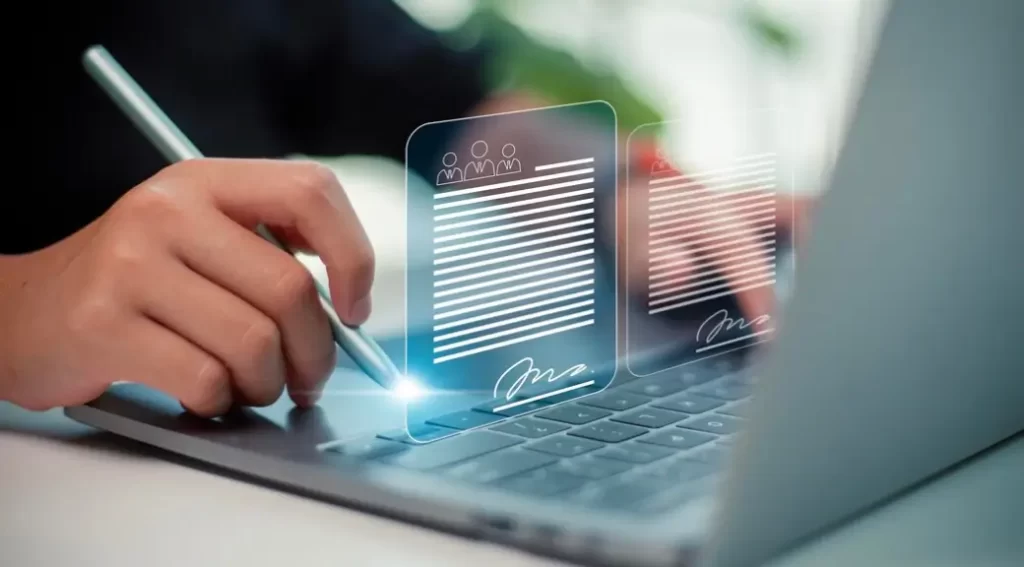In the era of remote work, digital solutions are critical, and one instrument stands out for its revolutionary power: electronic signature platforms. We will dig into the essential function of electronic signature technology, highlighting its benefits and contribution to the success of remote work. As organizations negotiate the changing landscape, they focus on how electronic signature platforms, like TRUESigner ONE, can improve operations. Join us as we explore the potential of Digital and electronic signatures as essential tools for businesses seeking efficiency in the dynamic world of remote work.
Benefits Of E-Signatures in a Remote Work Environment

In the fast-paced world of remote work, productivity and security are critical. Electronic and digital signatures provide game-changing solutions.
- Utilizing E-Signatures for Streamlined Operations:
Priority in the dynamic terrain of remote work, focusing on the numerous benefits, mainly electronic signature services, which assure secure transactions and increased productivity.
- Flexibility and Accessibility for Online Signatures:
Emphasizing the online nature of electronic signatures and e-signature solutions increases flexibility and accessibility, allowing smooth remote work operations.
- Enhanced Efficiency and Document Security:
Remote work activities are more efficient while assuring the authenticity and security of important documents.
How E-Signatures Enable Remote Work to Be a Success?
Remote work thrives on collaboration, and electronic signatures online are crucial in making this collaboration seamless. Electronic signatures play an important role in remote work by enhancing document security. Electronic signatures are essential in protecting sensitive papers required for remote work.
- Legal Validity: By ensuring legal validity, electronic signatures help maintain the integrity of contracts and agreements, making them legally binding in remote situations.
- Integration Capabilities: These revolutionary technologies readily interact with various software and apps, ensuring a consistent experience across several remote work platforms.
- End-to-end encryption ensures a secure bridge between virtual and physical realms. Digital signatures create a safe bridge by utilizing end-to-end encryption, ensuring the integrity of signed documents during transit in virtual environments.
- Tamper-Proof Signatures: The technique enables tamper-proof signatures, preventing unwanted revisions and ensuring document security in both physical and virtual realms.
- Streamlined workflow: Seamlessly integrating digital and electronic signatures improves workflow efficiency and reduces bottlenecks in distant work environments.
- Increased Productivity: Electronic signatures help boost productivity in the dynamic and fast-paced world of remote work by eliminating the need for physical documentation.
- Cross-Platform Compatibility: Keeping up with technical changes, these platforms provide cross-platform compatibility, allowing users to sign documents from various devices and operating systems.
- Audit Trails: Robust audit trail capabilities improve transparency in electronic transactions by providing a complete record of actions taken during the signing process.
- Enhanced Remote Work Experience with Collaborative Features. Aside from transaction security, the evolution of e-signature technology improves the whole remote work experience by offering collaborative capabilities and enabling real-time collaboration on documents across remote teams.
- Document Accessibility: electronic signatures make documents more accessible, allowing remote workers to access and sign crucial files from anywhere, increasing flexibility and productivity.
- Remote Accessibility: Seamless remote accessibility exemplifies the synergy between electronic signatures and remote work, allowing users to sign papers from anywhere while also encouraging a flexible and adaptive work environment.
- Real-Time Signer Verification: The technology allows for real-time signer verification, ensuring that distant workers are securely identified and validated throughout the signing process.
- Balance: Electronic businesses strike a balance between security, efficiency, and adaptability through comprehensive security measures that protect against cyber attacks and ensure data integrity.
- Scalability and flexibility: electronic signatures enable firms to adapt to changing workloads and remote work environments, achieving a balance between operational efficiency and adaptability.
Remote work success is more than just accomplishing tasks; it’s about building an atmosphere where teams can cooperate seamlessly across geographical barriers.
TRUESigner ONE: Elevating Remote Work Efficiency

TRUESigner ONE stands out as a dependable and versatile option among the numerous electronic signature platforms. TRUESigner ONE streamlines the signature process and includes additional features like multi-factor authentication, document tracking, and compliance monitoring, resulting in a secure and efficient remote work environment.
Summing up
In the context of remote work issues, integrating electronic signatures emerges as a strategic enterprise operational efficiencies integration of eSignatures, mainly through advanced platforms such as TRUESigner ONE, enables businesses to not only improve productivity and security but also encourage a collaborative and connected remote work ecosystem. Beyond transactions, electronic signatures set the path for a future of work that promotes productivity and success. This blog welcomes organizations to embrace this transformative technology, which will guide them to a new era of streamlined operations and increased productivity in the ever-changing world of remote work.






